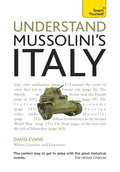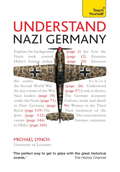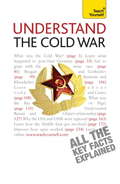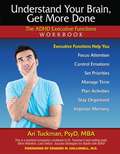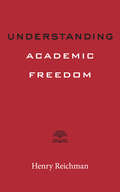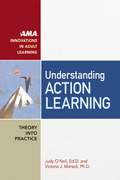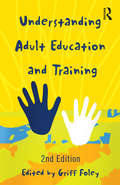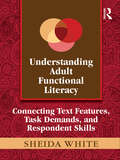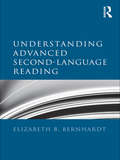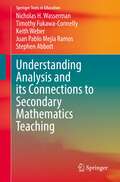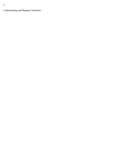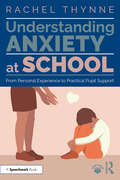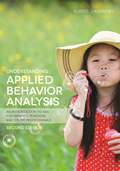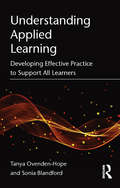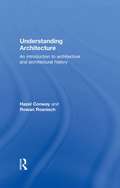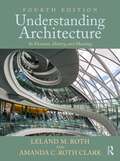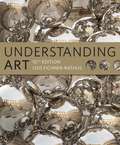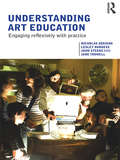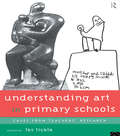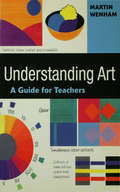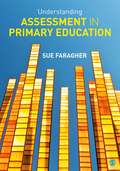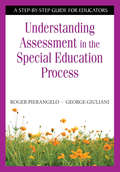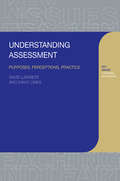- Table View
- List View
Understand Mussolini's Italy: Teach Yourself
by David EvansMussolini's Italy is a compelling introduction to this infamous fascist dictator and his extraordinary rule. Though sometimes regarded as a farcical ruler, Mussolini's 'brutal friendship' with Hitler and his tyrannical killing of over a million people cannot be ignored as crucial aspects of modern European history. David Evans' pacy and nuanced analysis of the rise and fall of this colourful yet dangerous dictator, will keep you gripped from beginning to end.
Understand Nazi Germany: Teach Yourself
by Michael LynchUnderstand Nazi Germany is an accessible introduction to one of the most controversial and debated periods of history. The years 1933-45 witnessed the take-over of Germany by a man and a movement whose racial and political policies are now regarded with universal abhorrence, but which at the time were genuinely popular. This gripping study explains not only the key events, but their causes and impacts.
Understand The Cold War: Teach Yourself (TY History)
by Carole Bryan JonesUnderstand the Cold War provides a fascinating insight into this complicated and hidden conflict, from how it began to the main characters involved and the culture it created. It will help you understand how the superpowers grew and vied for dominance, and how the balance was lost. All the important aspects of the war are covered, from what JFK and his assassin had in common to a discussion of whether the tension ended after the fall of the Berlin Wall. Give yourself the opportunity to understand the global reach of this 45-year-long conflict, which shaped the latter half of the twentieth century. NOT GOT MUCH TIME? One, five and ten-minute introductions to key principles to get you started. AUTHOR INSIGHTS Lots of instant help with common problems and quick tips for success, based on the author's many years of experience. EXTEND YOUR KNOWLEDGE Extra online articles at www.teachyourself.com to give you a richer understanding. THINGS TO REMEMBER Quick refreshers to help you remember the key facts. TRY THIS Innovative exercises illustrate what you've learnt and how to use it.
Understand Your Brain, Get More Done: The ADHD Executive Functions Workbook
by Edward M. Hallowell Ari TuckmanWritten for attention deficit hyperactivity disorder (ADHD) sufferers yet useful for anyone wishing make better use of their time, this book is abundant with effective strategies for combating problems related to inattention, procrastination, disorganization, mismanagement of time, and poor planning. It begins by carefully explaining the neurologic underpinnings of ADHD and focusing on specific executive functions--the brain-based processes that assist in planning, initiating, and carrying out tasks to complete projects. Then using exercises designed to identify areas that need addressing, it aims to "tune up" these executive functions for maximum productivity. In contrast to many books on ADHD, which can have good ideas but lack practical ways to apply them in everyday life, this guide includes specific recommendations for improving distractibility, working memory, attention, organization, time management, and response inhibition deficits. With strategies based in the science of how the ADHD brain processes information, this reference bridges the gap between knowledge and action.
Understanding Academic Freedom (Higher Ed Leadership Essentials)
by Henry ReichmanPart of the acclaimed Higher Ed Leadership Essentials series, this book surveys academic freedom's history and its application in today's universities.Academic freedom is once again at the epicenter of the crisis in higher education. A community college instructor in Iowa is pressured to resign after his pro-antifa social media comments garner vicious harassment that administrators find threatening to campus safety. A tenured biology professor at a college on Long Island is threatened with dismissal because she allegedly grades students too strictly. And in the wake of the COVID-19 pandemic, a conservative activist calls on his followers to take advantage of online classes to send "any and all videos of blatant indoctrination" to his organization so that it might expose and blacklist "leftist professors." These incidents from the 2019–20 academic year represent only the tip of the iceberg. Academic freedom, long heralded as a core value of American higher education, may now be in as much danger as at any time the 1950s. But what is "academic freedom"? A value upheld for one's supporters (but not one's opponents) when discussing a polarizing controversy? Or a narrow claim of privilege by a professorial elite, immune from public accountability?In this concise and compelling book, Henry Reichman, who chaired the American Association of University Professors' Committee on Academic Freedom and Tenure for nearly a decade, mounts a rigorous defense of academic freedom and its principal means of protection: the system of academic tenure. Probing academic freedom's role in multiple contexts, Reichman draws on a wealth of historical and contemporary examples to offer the first comprehensive introduction to the concept in all its manifestations. Elucidating its sometimes complicated meanings, Reichman argues that academic freedom—like its cousin, freedom of speech—cannot easily be defined but, instead, emerges from the contextual application of guiding principles developed and modified over time. He also explores why the rise of contingent faculty employment represents the gravest current threat to academic freedom; reveals how academic freedom is complicated by both fiercely polarized campus environments and the emergence of social media that extend speech beyond the lecture halls of the academy; and touches on the rights of students in and out of class, including treatment of student protest movements.
Understanding Action Learning: Theory Into Practice (Adult Learning Theory And Practice Book Ser.)
by Victoria J. Marsick Judy O'NeilAs much as adult learners can absorb in a classroom, they learn and retain a lot more on the job. Action Learning, or AL, can be based on any of several different schools of thought, and there is much debate as to which is ideal.The authors advocate tailoring the best attributes of each approach to the specific purpose and the learning environment. Drawing on theory from Self-Directed Learning, Learning from Experience, and Transformative Learning, Understanding Action Learning enables the reader to make an informed decision about which approach or combination to use in his or her organization, and provides:* a theoretical model that explains the different approaches to AL, and a framework for identifying which approach to use* a focus on co-design in creating Action Learning programs* practical tools, assessments, and exercises* illuminating stories and case studies from the fieldCombining top-shelf research with real-world experience, Understanding Action Learning is a crucial resource for adult educators everywhere.
Understanding Adult Education and Training
by Griff Foley'This is an impressive book that will be of wide interest to adult educators everywhere.Many of the book's contributors work at the University of Technology, Sydney - surely the world's pre-eminent institution for the study of adult learning, and the most open and generous location for debate. Its virtues are the book's.'Alan Tuckett, National Institute of Adult Continuing Education, UK'I am happy to endorse this book enthusiastically as being appropriate for a North American audience of adult educators.Though it's an intentionally introductory survey, it never talks down to readers, never condescends. On the other hand, it's not so intenationally erudite that it collagpses into theoretical posturing; it stays firmly grounded in and connected to practice.'Stephen Brookfield, University of St. Thomas, USAUnderstanding Adult Education and Training offers a broad overview of the field for adult educators and workplace trainers. It introduces the keys issues, debates and theories in a way which is relevant to practice. Its aim is to deepen readers' understanding of adult learning and education so that they can be better practitioners.Adult education is a diverse field so there is no single body of knowledge which is appropriate for all adult educators. Understanding Adult Education and Training introduces a wide range of formal theory from adult education and associated fields, and shows readers how they can use it their own circumstances.The first edition of this book has become a standard reference for students and professionals in Australia. This edition is fully revised and updated for an international readership.
Understanding Adult Functional Literacy: Connecting Text Features, Task Demands, and Respondent Skills
by Sheida White"This is a genuinely scholarly work ... It is based on [analysis of] the most up-to-date quantitative surveys that we have on adult literacy. These surveys are the gold standard in terms of documenting adult literacy in the United States ...The author analyzes these extensive surveys and puts them into a theoretical context in a way that has not been done before." – Rosemary J. Park, University of Minnesota "I don’t know of any book providing the same information. There is a shortage of literature in this area and the book is an excellent contribution." – Dolores Perin, Teachers College, Columbia University "The contribution of the theory is important – not only to adult literacy but to our understanding of the reading process at nearly every level ... Additionally, the application of multidimensional item response modeling to the new TTR theory offers a tantalizing view of how the predictive validity of a theory might be tested and used to provide practical results." – Larry Mikulecky, Indiana University Very often, individual differences in literacy performance are understood exclusively in terms of the characteristics of the reader. Drawing on a rich array of empirical research, the author presents a detailed and highly integrative new theory of functional literacy. The text-task-respondent (TTR) theory of functional literacy offers improved understanding of how successful performance on everyday literacy tasks involves a dynamic relationship among the text, the task, and the reader. This book will appeal primarily to assessment developers who wish to select tasks and texts of varying difficulty to yield more precise estimates of adult literacy; to researchers who study cognitive, linguistic, and discourse processes; and to teachers who want to find new ways to increase text comprehension among students, including English language learners and struggling readers. The text is appropriate for an advanced course in adult education, discourse analysis, educational measurement, educational psychology, literacy, or linguistics – or as a reference work for those interested in literacy.
Understanding Advanced Second-Language Reading
by Elizabeth B. BernhardtWhat distinguishes this book is its broad, yet thorough, view of theory, process, and research on adult second-language reading. Offering extensive discussions of upper-register second-language texts (both expository and narrative) that adult second-language readers encounter daily across the globe, it also presents an assessment schema for second-language text comprehension as well as for the assessment of teaching. Understanding Advanced Second-Language Reading: includes languages other than English in the discussion of second language reading is firmly anchored in a theory of second language reading ─ the concept of compensatory processing emphasizes the multi-dimensionality and dynamic nature of L2 reading development focuses on comprehension of upper-register literary texts balances theory and instructional practices. Filling the need for a coherent, theoretically consistent, and research-based portrait of how literate adolescents and adults comprehend, and learn to comprehend, at greater levels of sophistication and whether that ability can be enhanced by instruction, this is a must-have resource for reading and second-language researchers, students, and teachers.
Understanding Analysis and its Connections to Secondary Mathematics Teaching (Springer Texts in Education)
by Stephen Abbott Nicholas H. Wasserman Timothy Fukawa-Connelly Keith Weber Juan Pablo Mejía RamosGetting certified to teach high school mathematics typically requires completing a course in real analysis. Yet most teachers point out real analysis content bears little resemblance to secondary mathematics and report it does not influence their teaching in any significant way. This textbook is our attempt to change the narrative. It is our belief that analysis can be a meaningful part of a teacher's mathematical education and preparation for teaching. This book is a companion text. It is intended to be a supplemental resource, used in conjunction with a more traditional real analysis book.The textbook is based on our efforts to identify ways that studying real analysis can provide future teachers with genuine opportunities to think about teaching secondary mathematics. It focuses on how mathematical ideas are connected to the practice of teaching secondary mathematics–and not just the content of secondary mathematics itself. Discussions around pedagogy are premised on the belief that the way mathematicians do mathematics can be useful for how we think about teaching mathematics. The book uses particular situations in teaching to make explicit ways that the content of real analysis might be important for teaching secondary mathematics, and how mathematical practices prevalent in the study of real analysis can be incorporated as practices for teaching.This textbook will be of particular interest to mathematics instructors–and mathematics teacher educators–thinking about how the mathematics of real analysis might be applicable to secondary teaching, as well as to any prospective (or current) teacher who has wondered about what the purpose of taking such courses could be.
Understanding And Shaping Curriculum: What We Teach And Why
by Thomas W. HewittUnderstanding and Shaping Curriculum: What We Teach and Why introduces readers to curriculum as knowledge, curriculum as work, and curriculum as professional practice. Author Thomas W. Hewitt discusses curriculum from theoretical and practical perspectives to not only acquaint readers with the study of curriculum, but also help them to become effective curriculum practitioners.
Understanding Anxiety at School: From Personal Experience to Practical Pupil Support
by Rachel ThynneAn increasing number of children face feelings of anxiety and isolation, negatively impacting their mental health and wellbeing, as well as their attainment in school. Having battled social anxiety herself, Rachel Thynne knows first-hand how hard it can be to be misunderstood and receive little help. By understanding the communicative function of behaviours and seeing the person behind their actions, staff can learn to support and nurture pupils with consistency, empathy and positivity.This book explores anxiety in children and young people, unpicking social anxiety, situational mutism, school anxiety and separation anxiety within a school context, and shining a light on the importance of relationships, effective communication and self-regulation skills. A wealth of strength-based strategies are provided that can be implemented quickly and easily by busy school staff to alleviate anxiety, build self-esteem and increase feelings of safety and belonging. The book also supports sensitive and collaborative work with caregivers to achieve the biggest impact and includes real-life examples, case-studies and reflective opportunities to bring theory to life.Little adjustments can make a huge difference and have a positive, lifelong effect on the individual but also on the other pupils. Advocating for whole school approaches to create a culture where all pupils can thrive, Understanding Anxiety at School will enable school staff, including teachers and special educational needs coordinators (SENCOs), to recognise signs of anxiety and to provide support empathically and compassionately.
Understanding Applied Behavior Analysis, Second Edition: An Introduction to ABA for Parents, Teachers, and other Professionals
by Albert J. KearneyThis introductory guide to ABA demystifies the often complex terminology, the underlying principles, and commonly-used procedures of ABA using accessible, everyday language. This revised and updated edition reflects recent developments and introduces new key terms. Albert J. Kearney explains the kinds of learning and reinforcement processes that form the basis of ABA programs. Having covered these essential principles, he describes how the science of behavior analysis can be effectively applied to real life behavior problems. He looks at how behavior is assessed and various intervention techniques that are often employed with children who have autism and other special needs. Having laid these essential foundations, Kearney touches on more advanced topics: the applications of ABA in behavioral education, such as precision teaching and programmed instruction.
Understanding Applied Learning: Developing Effective Practice to Support All Learners
by Sonia Blandford Tanya Ovenden-HopeUnderstanding Applied Learning enables teachers, lecturers and educators to facilitate applied learning effectively with learners in schools, colleges and universities. It introduces teachers to the concept of applied learning in practice, cutting across any vocational and academic divide to show how this approach supports high-quality and effective outcomes for learners. Applied learning prepares and equips learners for life in the twenty-first century and lifelong learning. Offering practical guidance on why and how to adopt applied learning in all post-primary settings, this practical resource introduces and explores the core concepts, practices and benefits of using this approach. Illustrated with real-life scenarios, it examines why applied learning is relevant today, how it enables learners to connect knowledge with new situations, how to navigate and solve intellectual and skills-based problems and how to work collaboratively and develop higher-level thinking skills. Key topics covered include: A range of applied learning theories and strategies Relevant, Engaging, Active Learning (REAL) for successful knowledge and skills development The relevance of applied learning to employers Overcoming issues in embedding applied learning approaches How to embed creativity into learning experiences. Understanding Applied Learning is an authoritative, down-to-earth guide to facilitate applied learning effectively and successfully with students in secondary schools, colleges and universities. It is a source of support and inspiration for all those committed to high-quality and effective outcomes for learners.
Understanding Architecture: An Introduction to Architecture and Architectural History
by Hazel Conway Rowan RoenischA comprehensive introduction to architecture and architectural history and exceptional in its approach, this book explores architecture as a current practice in relation to history and in relation to the wider context of cultures, conservation and the environment. This new edition brings in the new emphasis on sustainability, urbanism, urban regeneration and cultural identity, in order to take a holistic approach to the subject of architecture. Highly illustrated, this book enables the reader to make sense of the experience of architecture and the built environment by understanding more about the form, construction, meaning and history of the subject.
Understanding Architecture: Its Elements, History, and Meaning
by Leland M. Roth Amanda C. Roth ClarkThe widely acclaimed and beautifully illustrated Understanding Architecture is now revised and expanded in its fourth edition, vividly examining the structure, function, history, and meaning of architecture, from prehistory to the present, in ways that are both accessible and engaging.Significant features of the fourth edition include: Expanded global essays outlining the encounters and interchanges, conflicts and accommodations, between disparate global communities A brand-new final chapter addressing the twenty-first century during which Western and global architectural developments have increasingly become one broad, interwoven expression. This chapter includes sections on CAD, Contemporary Architecture of the Twenty-First Century, Starchitects, Contemporary Architectural Prizes, Architecture and Energy Consumption, and Architecture Integrated with Nature New sections on Frank Lloyd Wright and Late Twentieth-Century Expressionism Thoroughly revised and expanded illustration, including over 700 images, over half of which are in full color, and 120 original line art drawings Understanding Architecture continues to be the only text in the field to examine architecture as a cultural phenomenon as well as an artistic and technological achievement with its straightforward, two-part structure: The Elements of Architecture and the History and Meaning of Architecture. Comprehensive and clearly written, Understanding Architecture is both a primer for visual environmental literacy and a classic survey of architecture. This is an essential book for anyone interested in our built environment and the layered historical meaning embodied within it.
Understanding Art (Tenth Edition)
by Lois Fichner-RathusUNDERSTANDING ART provides a balanced approach to appreciating art, incorporating coverage of masterworks from the past and present. Author Lois Fichner-Rathus combines a conversational writing style with rich images, all designed to inspire understanding of the art that surrounds you in everyday life.
Understanding Art Education: Engaging Reflexively with Practice
by Nicholas Addison Lesley Burgess John Steers Jane TrowellWhat is distinctive about art and design as a subject in secondary schools? What contribution does it make to the wider curriculum? How can art and design develop the agency of young people? Understanding Art Education examines the theory and practice of helping young people learn in and beyond the secondary classroom. It provides guidance and stimulation for ways of thinking about art and design when preparing to teach and provides a framework within which teachers can locate their own experiences and beliefs. Designed to complement the core textbook Learning to Teach Art and Design in the Secondary School, which offers pragmatic approaches for trainee and newly-qualified teachers, this book suggests ways in which art and design teachers can engage reflexively with their continuing practice. Experts in the field explore: The histories of art and design education and their relationship to wider social and cultural developments Creativity as a foundation for learning Engaging with contemporary practice in partnership with external agencies The role of assessment in evaluating creative and collaborative practices Interdisciplinary approaches to art and design Developing dialogue as a means to address citizenship and global issues in art and design education. Understanding Art Education will be of interest to all students and practising teachers, particularly those studying at M Level, as well as teacher educators, and researchers who wish to reflect on their identity as an artist and teacher, and the ways in which the subject can inform and contribute to education and society more widely.
Understanding Art in Primary Schools
by Les TickleEven the youngest children in primary schools are now required not only to make art, but also to study it, developing an understanding of the huge variety of art and craft from different times and places. But how do teachers actually tackle this, when most have not studied art themselves? This collection brings together case studies to show how a variety of teachers have used one particular art collection as a focus for practical art. Throughout, the voices of the children involved show us how they react to their encounters with art objects. This wealth of first hand evidence and practical experience will benefit all teachers.
Understanding Art: A Guide for Teachers
by Dr Martin W WenhamIn any area of the curriculum, children need to learn concepts, facts and skills through first-hand experience. In art, such learning depends on exploring and experimenting with the visual language through which artists communicate, and the visual elements such as line, colour and shape. The National Curriculum places strong emphasis on experimenting with and applying the visual elements. This book systematically explores the basic knowledge needed to do this effectively. The author deals with the visual elements of art, their properties, how they are related, and especially with the ways in which children's knowledge of each can be developed through simple but creative activities. Each element is placed in context, with extensive cross-referencing. The author shows how these elements can be observed in the children's environment and provides examples of how they have been used in works of art and craft. This accessible book does not assume any specialist knowledge or experience. It is essential for teachers at primary and secondary levels, art co-ordinators and for undergraduate and postgraduate level students of art education. Martin Wenham is an artist, calligrapher and stone carver who has exhibited at the Craft's Council. He has taught at the University of Leicester and has over twenty years' experience of teaching in primary and secondary schools.
Understanding Assessment in Primary Education
by Sue FaragherUnderstanding assessment and being able to use it effectively is at the heart of successful primary teaching. Aware of current policy and research, this book looks at the role and purpose of assessment within education, as well as providing detailed practical guidance on the main types of classroom assessment, including formative, summative, formal and informal methods. Real classroom examples and activities illustrate the practical uses, benefits, and limitations of each form of assessment, enabling you to feel confident about implementing these strategies in your own teaching. Coverage includes: The assessment planning cycle Innovative forms of assessment, including portfolios, debates, role play and mind mapping Assessment of learners with diverse needs, including SEN and EAL The use of technology in assessment Engaging children through self-assessment and peer-assessment This is essential reading for all primary initial teacher education courses, including university-based (PGCE, PGDE, BA QTS, BEd), school-based (SCITT, School Direct, Teach First) and employment-based routes into teaching, and beginning teachers. Sue Faragher is Head of Al Basma British School, a large private school in Abu Dhabi.
Understanding Assessment in Primary Education
by Sue FaragherUnderstanding assessment and being able to use it effectively is at the heart of successful primary teaching. Aware of current policy and research, this book looks at the role and purpose of assessment within education, as well as providing detailed practical guidance on the main types of classroom assessment, including formative, summative, formal and informal methods. Real classroom examples and activities illustrate the practical uses, benefits, and limitations of each form of assessment, enabling you to feel confident about implementing these strategies in your own teaching. Coverage includes: The assessment planning cycle Innovative forms of assessment, including portfolios, debates, role play and mind mapping Assessment of learners with diverse needs, including SEN and EAL The use of technology in assessment Engaging children through self-assessment and peer-assessment This is essential reading for all primary initial teacher education courses, including university-based (PGCE, PGDE, BA QTS, BEd), school-based (SCITT, School Direct, Teach First) and employment-based routes into teaching, and beginning teachers. Sue Faragher is Head of Al Basma British School, a large private school in Abu Dhabi.
Understanding Assessment in the Special Education Process: A Step-by-Step Guide for Educators
by Roger Pierangelo George A. GiulianiThis handbook explains applicable federal regulations and clarifies the referral, assessment, and evaluation process that helps determine student eligibility for special education and related services.
Understanding Assessment in the Special Education Process: A Step-by-Step Guide for Educators
by Roger Pierangelo George GiulianiAn ideal step-by-step reference for instructors who have not had specific training in assessing students with special needs, Understanding Assessment in the Special Education Process helps educators make the most effective use of available assessment options.
Understanding Assessment: Purposes, Perceptions, Practice
by David Lambert David LinesThis is the first title in this new series, which is aimed principally at secondary PGCE and BAEd students and school- and HEI-based tutors.Each book provides a digest of the central issues around a particular topic or issues, grounded in or supported by examples of good practice, with suggestions for further reading, study and investigation. The books are not intended as 'how to' books, but rather as books which will help students and teachers to explore and understand critical theoretical issues in ways that are challenging, that invite critical reappraisals of taken-for-granted practices and perceptions, and that provide appropriate links between theory and practice. Issues related to equal opportunities and special needs are included in each separate volume . There are boxes of questions, 'think abouts' , further reading, and bulleted summary lists for the reader.This book is written specifically for teachers-in-training which will clarify the 'big picture' of monitoring and assessment and makes the crucial distinctions in this large (and still taken-for-granted) field.The authors have written widely on assessment matters and have also worked in various capacities for the QCA (and its former manifestations). They are also engagerd in initial teacher education and so know the level and market extremely well.
